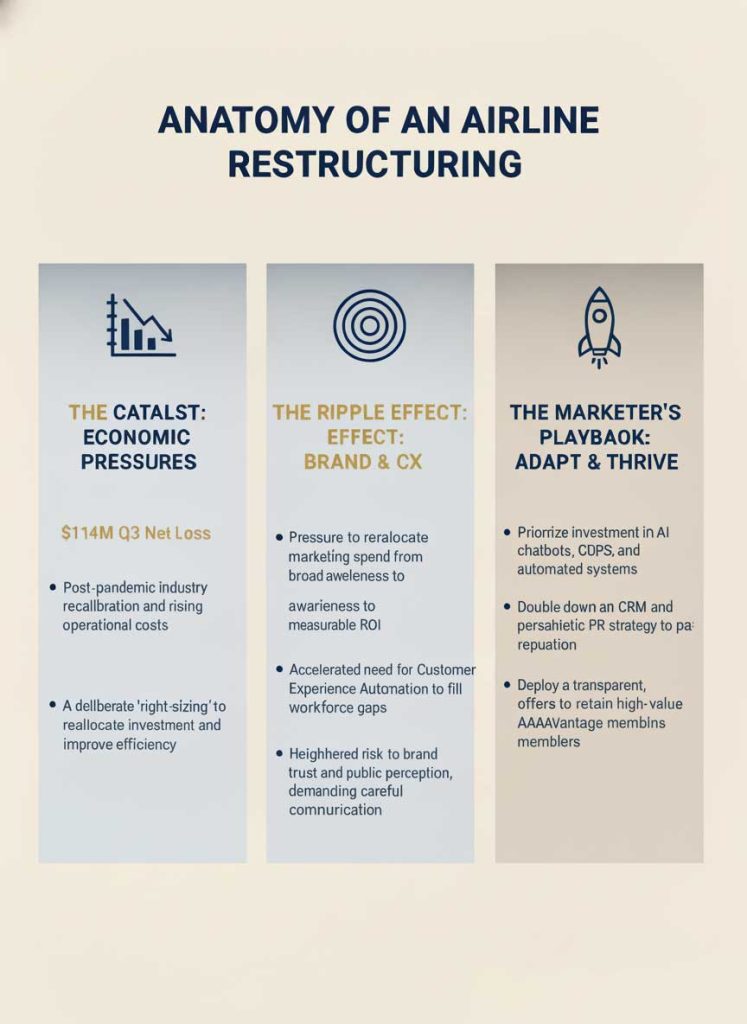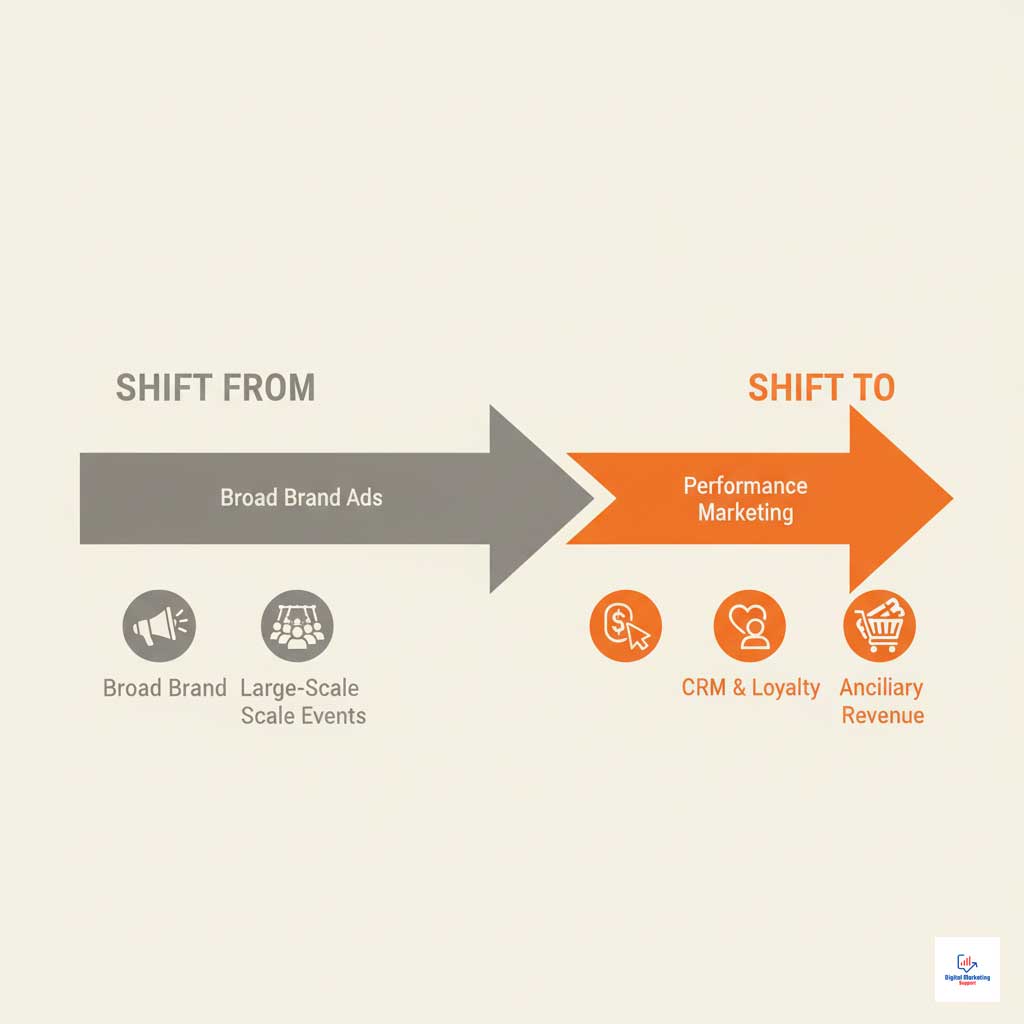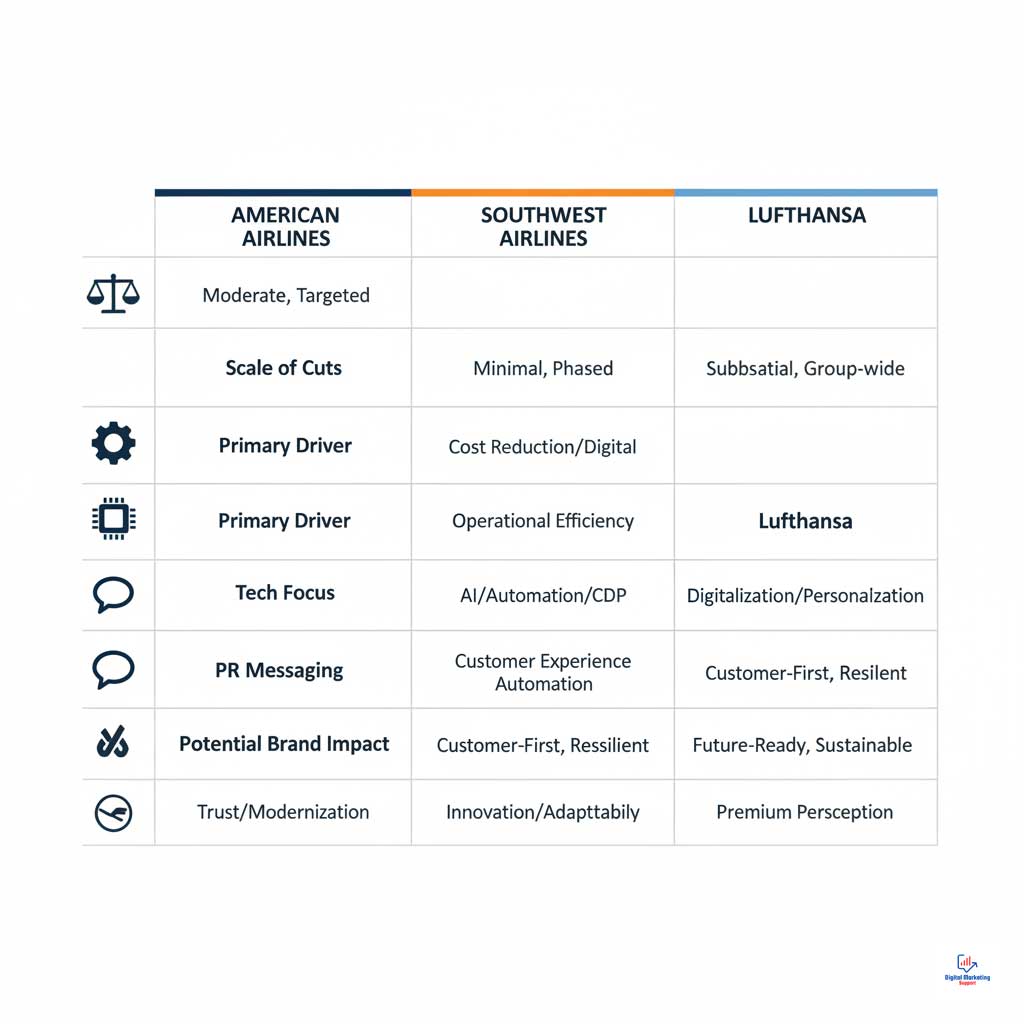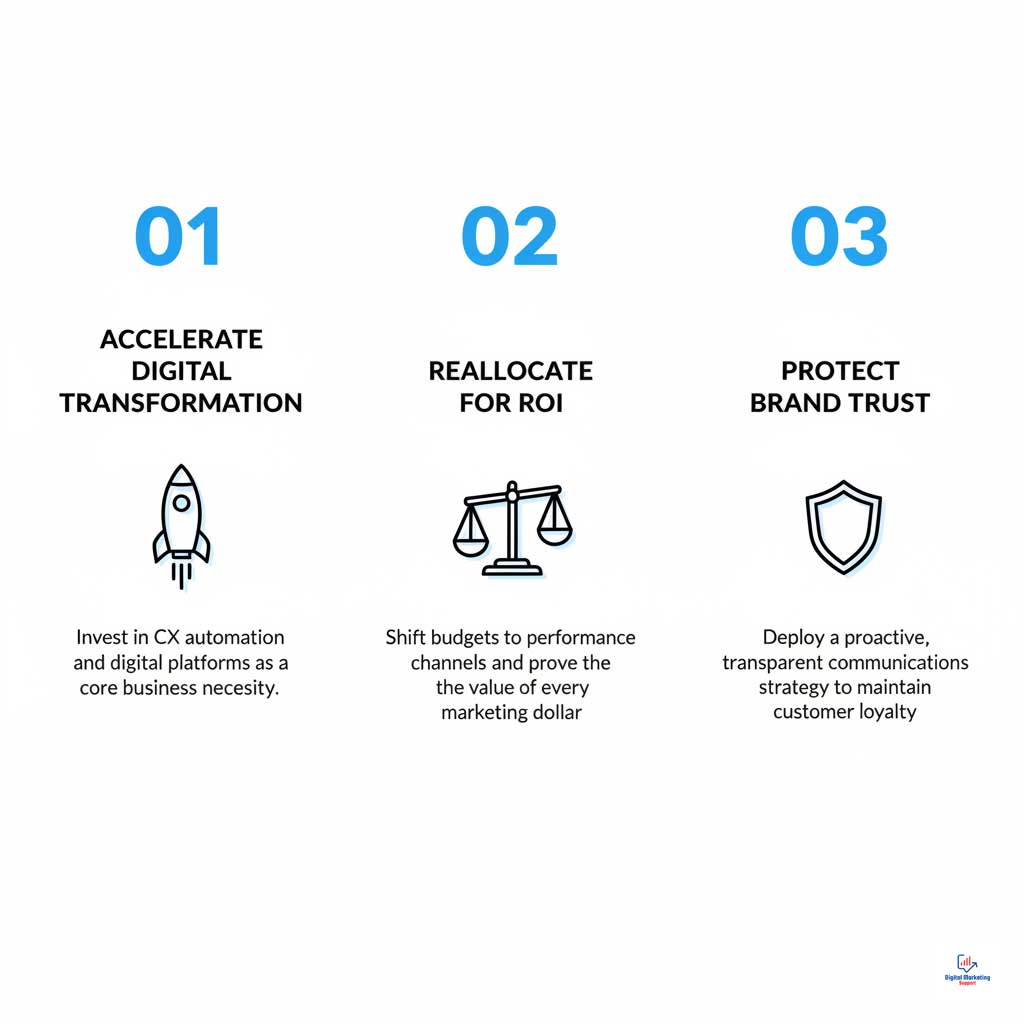In the volatile landscape of 2025, where economic headwinds and shifting consumer behaviors demand unprecedented agility, the airline industry finds itself at a critical inflection point. The November 2025 announcement of American Airlines management cuts at its Fort Worth headquarters is far more than a corporate memo; it’s a resonant signal of a profound industry-wide recalibration.
Table of Contents
For marketing leaders and brand strategists, this move is not merely about headcount—it’s a catalyst for a fundamental overhaul of brand operations, demanding an accelerated shift towards digital-first marketing, deep reliance on customer experience automation, and a leaner, more data-driven organizational mindset.

This in-depth analysis moves beyond the headlines to provide a strategic playbook for navigating this new reality. We will deconstruct the underlying drivers of this airline workforce reduction in 2025, explore the direct and indirect consequences for marketing and customer experience, and offer actionable frameworks for protecting brand trust while driving measurable growth. The American Airlines Fort Worth layoffs represent a pivotal moment, and understanding its operational impact is crucial for any brand aiming to thrive in the years ahead.

The Core Issue: Deconstructing the “Workforce Right-Sizing” at American Airlines
The term “layoffs” often conjures images of broad, sweeping cuts. However, the recent moves at American Airlines are more nuanced, representing a surgical adjustment to its corporate core. Understanding the specifics is the first step in grasping the full airline brand operations impact.
Defining the Scope: More Than Just Layoffs
The American Airlines management cuts were strategically framed as a “workforce right-sizing.” This deliberate phrasing points to a focused reduction of management and support staff roles rather than frontline, customer-facing employees. The move primarily impacted corporate departments at the Fort Worth headquarters, including finance, IT, corporate communications, and commercial teams.
This decision was not made in a vacuum. It came on the heels of the airline reporting a challenging Q3 net loss of $114 million, providing a clear financial impetus for the cost-saving measures. This context is essential; the cuts are less about a failing business and more about a strategic pivot to enhance efficiency and reallocate precious capital toward long-term priorities, a common theme in the current airline corporate restructuring impact across the industry.
Why This Matters for Brand Operations: The Connection Between HQ and the Customer
It’s a common misconception that corporate roles are insulated from the customer experience. In reality, the teams affected by the American Airlines management cuts form the central nervous system of brand operations. A reduction in this corporate backbone can create significant ripple effects that ultimately touch the end consumer.

The Hidden Impact on Digital and Marketing Velocity
Consider the potential consequences:
- Slower Digital Innovation: With fewer IT project managers and business analysts, the pipeline for crucial updates to the American Airlines app, website, or internal customer service tools could slow down. This directly affects the digital experience.
- Reduced Marketing Analytics: A leaner marketing analytics team means less capacity for deep-dive campaign analysis, A/B testing, and personalization initiatives. This can lead to less effective ad spend and a weaker understanding of customer behavior.
- Strained Internal Communications: A reduction in communications staff can slow the flow of information from corporate to the frontline, potentially leaving gate agents or call center staff without the latest information during disruptions, which directly impacts customer interactions.
This chain reaction highlights the critical airline brand operations impact. The efficiency gained at the corporate level must be carefully balanced against the potential degradation of the customer-facing experience. The American Airlines Fort Worth layoffs serve as a stark reminder that brand perception is shaped by a thousand internal processes working in harmony.
Latest Industry Trends: The Macro-Forces Driving Airline Corporate Restructuring
The American Airlines management cuts are not an isolated event but a symptom of broader economic and operational pressures shaping the global aviation industry. To fully understand their significance, one must view them within the context of a sector undergoing a massive post-pandemic correction.
The Post-Pandemic Correction: From Hiring Sprees to Strategic Trims
The period from 2022 to 2024 was characterized by a frenzied “revenge travel” boom. Airlines, including American, hired aggressively to meet the unprecedented surge in demand. However, the landscape of 2025 is starkly different, defined by a new set of challenges that necessitate a leaner approach to corporate overhead.
Key drivers behind this airline workforce reduction in 2025 include:
- Soaring Labor Costs: New, more expensive contracts for pilots, flight attendants, and other unionized groups have significantly increased operational expenses.
- Persistent Supply Chain Constraints: Delays in aircraft deliveries from manufacturers like Boeing and Airbus have limited capacity growth, making it harder to generate revenue to offset rising costs.
- Softening Demand: While travel remains robust, the explosive growth of the initial post-pandemic years is normalizing, and signs of softening demand in certain markets are forcing airlines to adjust their financial outlooks.
This confluence of factors is compelling carriers to seek efficiencies wherever possible, and corporate and management roles are often the first place they look. This trend is a clear example of the wider airline corporate restructuring impact.
Case Studies in Airline Restructuring: Lessons from Southwest and Lufthansa
Examining how other major carriers have navigated similar challenges provides valuable insight into the potential paths American Airlines might take and the pitfalls it must avoid.
Southwest Airlines: A Lesson in Crisis Communications
Southwest’s recent history, including its operational meltdown and subsequent corporate headcount reductions, offers a powerful lesson on the importance of an effective airline corporate communications strategy. While its workforce adjustments were aimed at streamlining operations, the public memory of widespread flight cancellations meant the airline had to manage its messaging with extreme care. The key takeaway is that after any internal disruption, including layoffs, a brand’s ability to communicate transparently and maintain customer service levels is paramount to preserving brand trust.
Lufthansa Group: A Blueprint for Digital Transformation
In contrast, Lufthansa Group embarked on a multi-year transformation program that coupled large-scale cost-cutting with massive investments in digitalization. They focused on consolidating their digital platforms and aggressively re-skilling their marketing teams to manage complex personalization and revenue management systems. This approach demonstrates how workforce reductions can be framed as part of a forward-looking strategy, positioning the company for a more efficient, tech-driven future. This model underscores the growing importance of airline digital transformation in 2025 as a response to staffing changes.
These examples show that the airline brand operations impact of restructuring is not predetermined; it is shaped by the strategic choices made in technology, communication, and customer experience investment.
Practical Strategies: A Marketer’s Playbook for Navigating the New Reality
For marketing, communications, and customer experience leaders, the American Airlines management cuts signal a mandate to do more with less. This requires a strategic pivot away from traditional playbooks and toward a model built on agility, data, and technology. This is where a thoughtful workforce recalibration marketing implications plan becomes essential.
The Budget Pivot: Reallocating Spend for Maximum ROI
In an environment of intense cost scrutiny, marketing budgets are often the first to be reviewed. The challenge is not just to cut costs but to reallocate them for maximum efficiency and demonstrable return on investment.

Here is how airline budget reallocation affects digital ad spend and CRM in 2025:
- Shift from “Brand” to “Performance”: Expect a reduction in broad, top-of-funnel brand awareness campaigns in favor of highly measurable, bottom-of-funnel performance marketing. This means more investment in paid search, retargeting, and affiliate marketing where a direct line can be drawn between spend and ticket sales or ancillary revenue.
- Deepen CRM and Loyalty Investment: It is five times more expensive to acquire a new customer than to retain an existing one. This adage becomes law after corporate restructuring. Marketing teams must double down on CRM, using customer data to drive personalized offers, targeted communications, and deeper engagement with the AAdvantage loyalty program.
- Focus on High-Margin Ancillary Revenue: Marketing efforts will increasingly focus on promoting high-margin ancillary products like seat upgrades, lounge access, and co-branded credit cards. These are powerful revenue drivers that can be directly influenced by targeted digital marketing campaigns.
The Technology Imperative: Leveraging AI and Automation to Fill Gaps
A reduction in human capital necessitates an increase in technological capability. The most significant long-term effect of the American Airlines management cuts will be the acceleration of customer experience automation for airlines. Technology is no longer a “nice to have”; it is the essential connective tissue that allows a leaner organization to maintain, and even improve, its brand operations.

This table details the key automation technologies and their impact:
| Automation Technology | Primary Function | Impact on Brand Operations | Key Benefit |
| AI-Powered Chatbots & IVAs | Handle high-volume, low-complexity queries (flight status, baggage fees, basic booking). | Drastically reduces call center volume and wait times, freeing human agents for complex issues. | 24/7 support, lower cost-to-serve, improved first-contact resolution. |
| Automated Rebooking Systems | Proactively rebook passengers on new flights during irregular operations (IROP). | Manages customer frustration during delays/cancellations, reducing manual work for gate agents. | Higher Net Promoter Score (NPS), improved operational efficiency, reduced compensation costs. |
| Customer Data Platform (CDP) | Unify siloed customer data (booking history, loyalty status, website behavior) into a single profile. | Enables deep, real-time personalization across all touchpoints (email, app, website). | Increased customer lifetime value (CLV), higher conversion rates on ancillary offers. |
| Predictive Churn Models | Use machine learning to identify high-value loyalty members at risk of churning. | Allows marketing to deploy proactive, targeted retention campaigns and special offers. | Lower loyalty program churn, preserved high-margin revenue stream. |
Investing in this tech stack is central to any successful airline digital transformation in 2025. Citing a real-world instance, one major carrier successfully reduced its call center volume by 40% and improved its NPS by 6 points after implementing a robust automated rebooking flow—a clear testament to the power of this strategy.
The Communications Strategy: Protecting Brand Trust After Layoffs
No matter how strategically necessary, layoffs create a vulnerability in brand perception. A proactive and empathetic PR strategy after layoffs is non-negotiable. The core challenge is managing the American Airlines Fort Worth HQ workforce change implications for brand trust.
A robust airline corporate communications strategy should include:
- Transparent and Controlled Messaging: Develop a clear, consistent narrative that frames the American Airlines management cuts as a strategic move to ensure the long-term health and stability of the airline, ultimately benefiting customers.
- Proactive Social Listening: Deploy social listening tools to monitor public sentiment in real-time. This allows the communications team to quickly address misinformation, respond to customer concerns, and manage the narrative proactively.
- Empowering Frontline Employees: Equip customer-facing staff with clear talking points and information. When customers ask questions, the frontline team must be prepared with consistent and reassuring answers.

Comparative Analysis: Strategic Responses to Workforce Reductions
The way an airline manages its workforce reduction and communicates it to the market reveals much about its long-term strategy and priorities. The approach taken will directly influence the airline brand operations impact. The following table compares potential strategies, drawing on recent industry events.
| Airline Approach | American Airlines (Hypothetical Path) | Southwest Airlines (Based on Past Events) | Lufthansa Group (Transformation Model) |
| Scale of Cuts | Small, targeted management & support roles to improve corporate efficiency. | Broader corporate headcount reduction aimed at overall cost control. | Large-scale, multi-year program integrated with a complete business overhaul. |
| Primary Driver | Profitability pressure after a quarterly loss; focus on operational efficiency. | Streamlining operations and controlling costs after a period of rapid hiring. | A proactive, long-term strategy for full business transformation and digitalization. |
| Tech Focus | Immediate investment in CX automation, CRM, and ancillary revenue tools to offset staff cuts. | Focus on modernizing core operations technology and customer refund systems to fix past issues. | Deep investment in digital platform consolidation, advanced data analytics, and re-skilling. |
| PR Messaging | “Right-sizing for long-term priorities and reinvestment in the customer journey.” | Emphasis on improving operational reliability and a renewed commitment to customer care. | “Investing in a sustainable, digital-first future to better serve our customers.” |
| Potential Brand Impact | Short-term risk of perceived instability, but long-term opportunity to be seen as efficient and innovative. | Reputational risk tied to past operational failures, making transparency critical. | Positioned as a proactive, forward-thinking industry leader embracing change. |
This comparison makes it clear that the American Airlines Fort Worth layoffs are a strategic choice point. The path they choose in technology investment and public communication will determine whether the move is perceived as a sign of weakness or a bold step toward a more resilient future.

Summary & Key Takeaways: Navigating the New Operational Landscape
The American Airlines management cuts are a microcosm of the immense pressures and strategic pivots occurring across the entire airline industry. They are not simply a cost-cutting measure but a definitive signal of an accelerated shift toward a new operational model—one that is leaner, more technologically reliant, and intensely focused on measurable ROI.

For brand and marketing leaders, the key takeaways are clear. The primary effects of this airline workforce reduction in 2025 on brand operations will manifest in three core areas:
- Accelerated Digital Transformation: The imperative to invest in customer experience automation for airlines and robust digital marketing platforms is no longer optional; it is essential for survival and growth.
- Strategic Budget Reallocation: Marketing success will be defined by the ability to shift budgets fluidly to high-performance channels, prove the ROI of every activity, and directly contribute to ancillary revenue and customer lifetime value.
- Proactive Brand Stewardship: The need for a sophisticated airline corporate communications strategy is paramount. Protecting brand trust in the wake of an airline corporate restructuring impact requires transparency, empathy, and a relentless focus on the customer experience.
Ultimately, the leaders who will thrive in this new environment are those who view the American Airlines Fort Worth layoffs not as a crisis, but as a catalyst. It is an opportunity to champion data-driven strategies, secure investment in a modern technology stack, and solidify marketing’s role as a critical driver of both revenue and unwavering customer loyalty.
Frequently Asked Questions (FAQs)
How will American Airlines’ management cuts affect my flights?
The current staff reductions are focused on corporate and support roles at the Fort Worth headquarters and are not expected to have a direct, immediate impact on flight schedules or frontline staff such as pilots, flight attendants, or gate agents. The airline’s stated goal is to improve back-office efficiency to better support its core operations.
Why did American Airlines lay off management staff?
American Airlines initiated these management cuts after reporting a net loss of $114 million in the third quarter of 2025. The company described the move as a strategic “right-sizing” of its workforce to control costs, enhance organizational efficiency, and reallocate investments toward long-term strategic priorities.
Will these layoffs at American Airlines affect customer service?
While frontline customer service agents were not the focus of these cuts, a reduction in corporate support staff could indirectly lead to a greater reliance on automated systems, such as AI chatbots and self-service tools on the app and website. The airline’s goal is to use technology to handle common inquiries more efficiently, freeing up human agents for more complex issues.
Is American Airlines reducing its marketing spend after these cuts?
It is more likely that American Airlines will reallocate its marketing budget rather than simply reduce it. Spending will probably shift away from broad brand campaigns toward more measurable, high-ROI digital channels like performance marketing, CRM, and loyalty program engagement to drive direct revenue.
How can airlines protect their brand reputation after layoffs?
Airlines can protect their brand reputation by communicating with transparency about the business reasons for the cuts, showing empathy for affected employees, and reinforcing their long-term commitment to customers. A proactive PR strategy after layoffs, including robust social media listening, is critical.
Which automation tools can help airlines with fewer corporate staff?
Key automation tools include AI-powered chatbots for 24/7 customer support, automated rebooking systems to manage flight disruptions, Customer Data Platforms (CDPs) for advanced marketing personalization, and Robotic Process Automation (RPA) for streamlining back-office administrative tasks.
How do workforce reductions impact airline loyalty programs?
Workforce reductions put more pressure on loyalty programs like AAdvantage to retain high-value customers. Marketers will likely increase their focus on personalized offers and targeted CRM campaigns to prevent churn and demonstrate the ongoing value of the program to its most frequent flyers.
What PR messaging is most effective after small-scale layoffs?
The most effective messaging frames the decision as a strategic and necessary step for long-term health and stability. It should be transparent, empathetic, and quickly pivot to reaffirm the company’s unwavering commitment to its customers, safety, and core mission.
Are airline digital investments increasing because of headcount cuts?
Yes, headcount reductions in corporate roles often act as a catalyst for accelerating investments in airline digital transformation in 2025. Companies look to technology and automation to create efficiencies, fill operational gaps, and maintain a high standard of customer experience with a leaner workforce.
How can AI safely replace manual customer support tasks?
AI can be safely implemented by first targeting high-volume, low-complexity tasks like answering frequently asked questions, providing flight status updates, or processing simple baggage claims. This ensures accuracy and efficiency while freeing up human agents to manage more complex or emotionally charged customer situations that require a human touch.
What is airline corporate restructuring?
Airline corporate restructuring refers to significant changes a company makes to its business model, financial structure, or organization to adapt to market changes or address financial challenges. This process can include actions like workforce reductions, asset sales, budget reallocations, and strategic shifts in technology and operations.
How does this American Airlines workforce change compare to others in the industry?
The American Airlines management cuts are consistent with a broader industry trend. In the past year, other major carriers like Southwest Airlines and Air Canada have also announced similar reductions in their corporate and management staff, signaling a collective effort across the industry to control costs and optimize operations amid economic uncertainty.








